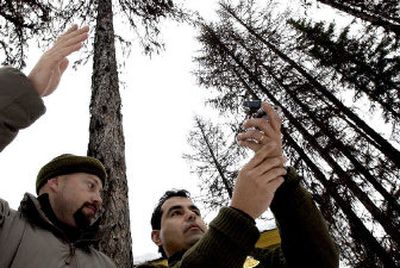Wising up to winter

PRIEST LAKE, Idaho – Avalanches weren’t much of a worry during the eight years Jose Leal spent guarding California’s sunny border with Mexico.
But the senior U.S. Border Patrol agent now works out of Bonners Ferry, Idaho, where days can be so cloudy and snowy even his satellite phone is useless. There might not be as many illegal aliens wandering the thick forest along the Canadian border, but Leal has a new set of risks on his patrols, including grizzly bears, snow slides and hypothermia.
“We really can’t rely on electronic equipment,” Leal said. “You have to rely on your experience and senses.”
Leal and 20 other law officers from both sides of the border are spending this week in the Selkirk Mountains near Priest Lake, learning the essentials of backcountry winter survival. In the first class of its kind for the nation, the officers are being schooled in everything from how to start a fire with flint and steel to wilderness medicine to nighttime navigation using only a compass and map. Another class is planned for next month.
“These guys have the potential to use this just about any day they’re at work,” said Steve Thomson, a course organizer and the law enforcement liaison for the U.S. Attorney’s Eastern District of Washington.
The students include veteran officers from the Border Patrol, U.S. Forest Service, Washington Department of Fish and Wildlife and even the Royal Canadian Mounted Police. The Mounties and the Border Patrol work together closely, sharing intelligence and providing rescue assistance, Thomson said. The curriculum was designed with help from experts at Spokane Falls Community College and even the U.S. Air Force Winter Survival School.
Since 9/11, the Border Patrol has more than quadrupled its previous force of agents along a 309-mile stretch of border between Washington’s Cascade Mountain range and Glacier National Park in Montana, said Lonnie Moore, a spokesman for the agency’s Spokane office. Before the terrorist attacks, about 30 agents worked that stretch, which contains some of the nation’s most rugged, remote terrain.
With security being tightened at major border entries, smugglers have sought new ways to get into the country. The backcountry border with Canada simply couldn’t be ignored, Moore said. Sometimes, this means overnight patrols through wilderness areas along the border, or long shifts on the back of a snowmobile.
“It’s going to put us in a better position to potentially catch terrorism suspects,” Moore said, adding, “Failure’s just not an option for us.”
The training is also meant to deepen the ties between officers in Canada and the U.S., as well as cooperation between federal agents and state and local officials. A state game warden could help spot a drug smuggler just as a Border Patrol agent could call in a suspected poacher. Canada has its own reasons for tightening security, said Cpl. Luc Quenneville, a training session attendee from the Royal Canadian Mounted Police detachment in Creston, B.C.
“We have cocaine and guns coming north,” he explained.
Border Patrol agents stationed along the Canadian border all have previous experience along the Mexican border, said James Frackelton, a senior agent in Metaline Falls, Wash. Down south, getting lost was a relative cakewalk. If there wasn’t radio or cell phone service, agents could use the sun to find their way home, or even get their bearing from the North Star. Often, there was a border fence they could follow.
“Here, you’ve got to know where you’re at all the time,” he said. “This is rugged territory. It can be life-threatening.”
Three Mounties learned that firsthand last winter, when their snowmobiles became stuck in deep powder far from radio contact near British Columbia’s border with Idaho. They were eventually rescued by the Border Patrol.
Border Patrol agents now employ electronic sensors, satellite imagery and even remote video monitors for surveillance, but the stranded snowmobile incident was a wake-up call for agencies not to forget the importance of old-fashioned survival training, said Thomson, with the U.S. attorney’s office.
“The Mounties came out of it OK, but it just emphasized the need to do this,” he said. One of the stranded Mounties even helped with training this week.
On Thursday, officers were trained in backcountry compass and map navigation. Most carry handheld global positioning systems on regular patrols, but the devices are often unable to link with satellites through heavy cloud cover or a thick tree canopy, Thomson said. The training exercise continued long after dark, when agents strapped on snowshoes and were sent into the forest to search for targets using their new skills.
Earlier in the week, officers had to start a fire at night during a heavy snowstorm. The fuel was wet and the only way to light the fire was by creating sparks with a knife blade scraped over a flint. Agents learned quickly the importance of carrying a wad of dry tinder, Thomson said, holding up a clump of moss and lichen he had earlier stripped from a nearby tree branch.
“Old-school technology,” he said, stashing the wad in a jacket pocket. “Unfortunately, we grow up in a soft environment these days. Frontiersmen had to carry tinder boxes with them at all times.”
Thomson, the former sheriff of Whitman County, Wash., admitted there’s nothing easy about tracking smugglers and illegal aliens through the deserts along the Mexican border, but the winter survival skills being taught this week at Priest Lake are eye-opening for even the most veteran agents.
“Most of ‘em are Texans,” Thomson explained, smiling.